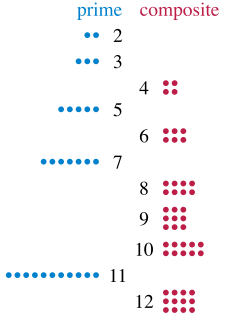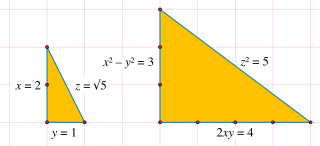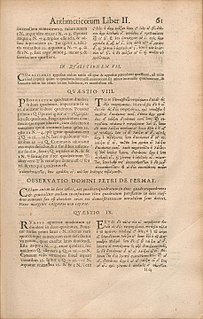The works of the 17th-century mathematician Pierre de Fermat engendered many theorems. Fermat's theorem may refer to one of the following theorems:

Number theory is a branch of pure mathematics devoted primarily to the study of the integers and integer-valued functions. German mathematician Carl Friedrich Gauss (1777–1855) said, "Mathematics is the queen of the sciences—and number theory is the queen of mathematics." Number theorists study prime numbers as well as the properties of mathematical objects made out of integers or defined as generalizations of the integers.

A prime number is a natural number greater than 1 that is not a product of two smaller natural numbers. A natural number greater than 1 that is not prime is called a composite number. For example, 5 is prime because the only ways of writing it as a product, 1 × 5 or 5 × 1, involve 5 itself. However, 4 is composite because it is a product in which both numbers are smaller than 4. Primes are central in number theory because of the fundamental theorem of arithmetic: every natural number greater than 1 is either a prime itself or can be factorized as a product of primes that is unique up to their order.
Fermat's little theorem states that if p is a prime number, then for any integer a, the number ap − a is an integer multiple of p. In the notation of modular arithmetic, this is expressed as
In mathematics, a Fermat number, named after Pierre de Fermat, who first studied them, is a positive integer of the form
Lagrange's four-square theorem, also known as Bachet's conjecture, states that every natural number can be represented as the sum of four integer squares. That is, the squares form an additive basis of order four.
In mathematics, a proof by infinite descent, also known as Fermat's method of descent, is a particular kind of proof by contradiction used to show that a statement cannot possibly hold for any number, by showing that if the statement were to hold for a number, then the same would be true for a smaller number, leading to an infinite descent and ultimately a contradiction. It is a method which relies on the well-ordering principle, and is often used to show that a given equation, such as a Diophantine equation, has no solutions.

In mathematics, a constructible polygon is a regular polygon that can be constructed with compass and straightedge. For example, a regular pentagon is constructible with compass and straightedge while a regular heptagon is not. There are infinitely many constructible polygons, but only 31 with an odd number of sides are known.
In additive number theory, the Fermat polygonal number theorem states that every positive integer is a sum of at most nn-gonal numbers. That is, every positive integer can be written as the sum of three or fewer triangular numbers, and as the sum of four or fewer square numbers, and as the sum of five or fewer pentagonal numbers, and so on. That is, the n-gonal numbers form an additive basis of order n.
In additive number theory, Fermat's theorem on sums of two squares states that an odd prime p can be expressed as:

A Pythagorean prime is a prime number of the form 4n + 1. Pythagorean primes are exactly the odd prime numbers that are the sum of two squares; this characterization is Fermat's theorem on sums of two squares.
In additive number theory, an additive basis is a set of natural numbers with the property that, for some finite number , every natural number can be expressed as a sum of or fewer elements of . That is, the sumset of copies of consists of all natural numbers. The order or degree of an additive basis is the number . When the context of additive number theory is clear, an additive basis may simply be called a basis. An asymptotic additive basis is a set for which all but finitely many natural numbers can be expressed as a sum of or fewer elements of .
In mathematics and statistics, sums of powers occur in a number of contexts:

In number theory, Fermat's Last Theorem states that no three positive integers a, b, and c satisfy the equation an + bn = cn for any integer value of n greater than 2. The cases n = 1 and n = 2 have been known since antiquity to have infinitely many solutions.
A timeline of number theory.

Fermat's right triangle theorem is a non-existence proof in number theory, published in 1670 among the works of Pierre de Fermat, soon after his death. It is the only complete proof given by Fermat. It has several equivalent formulations, one of which was stated in 1225 by Fibonacci. In its geometric forms, it states:
In mathematics, statistics and elsewhere, sums of squares occur in a number of contexts:
In mathematics, Legendre's three-square theorem states that a natural number can be represented as the sum of three squares of integers
In number theory, the sum of two squares theorem relates the prime decomposition of any integer n > 1 to whether it can be written as a sum of two squares, such that n = a2 + b2 for some integers a, b.